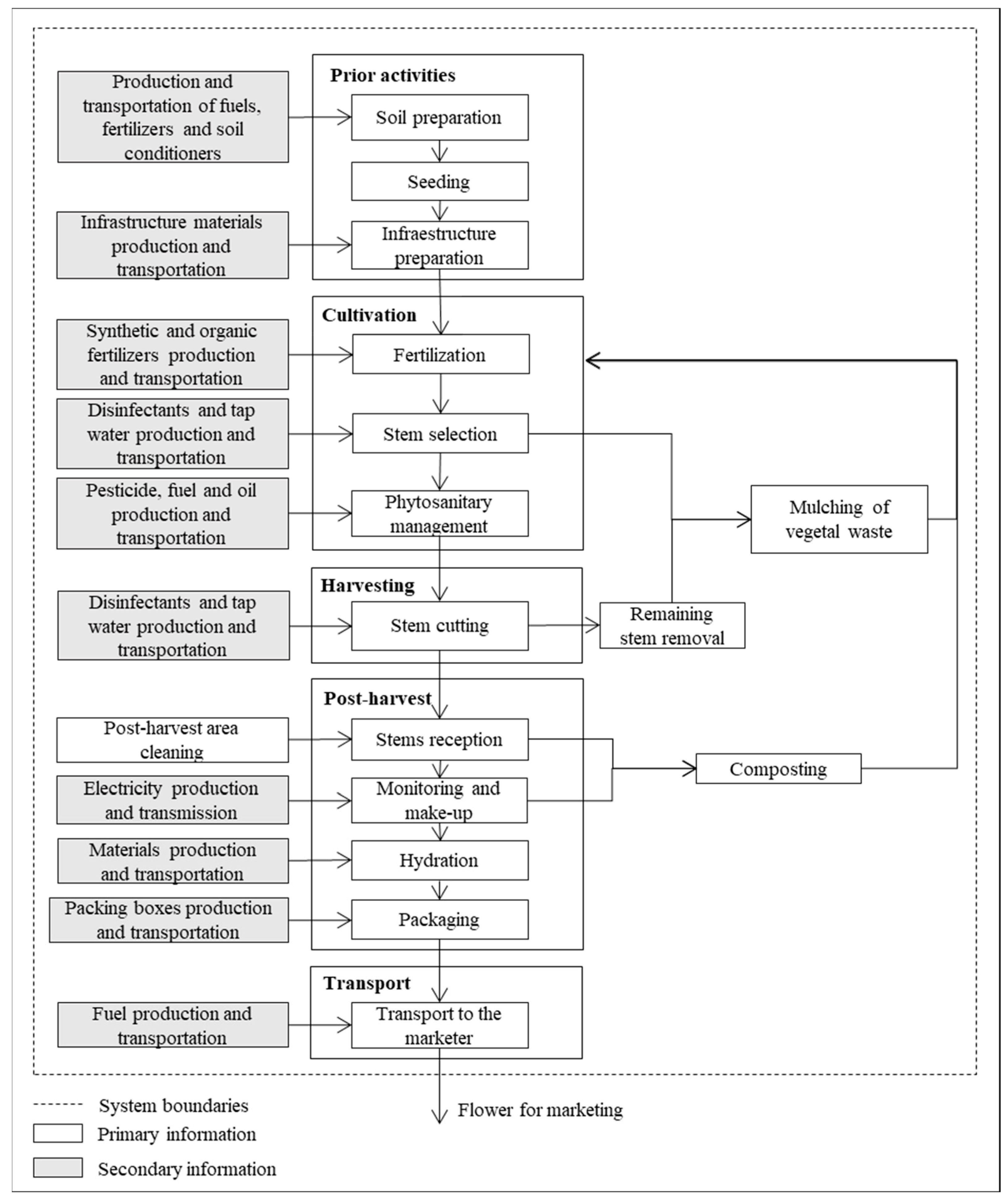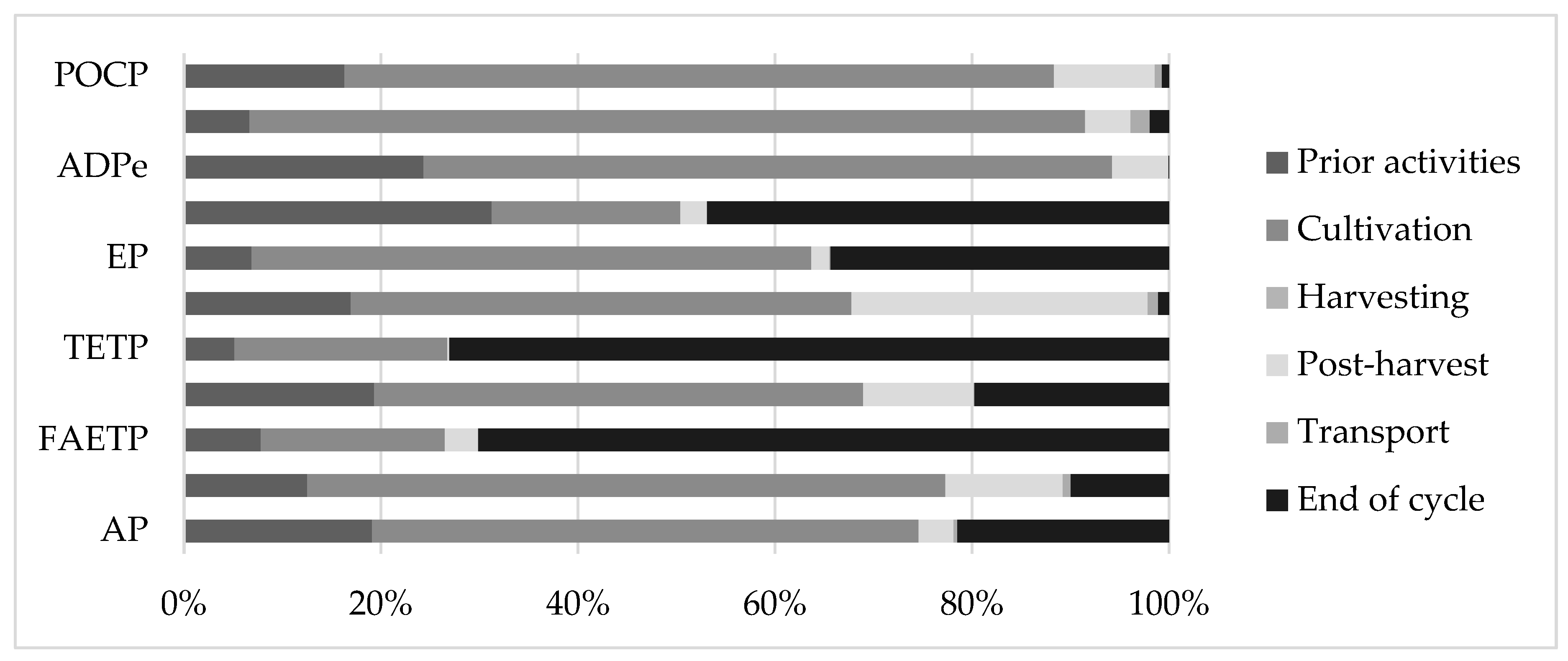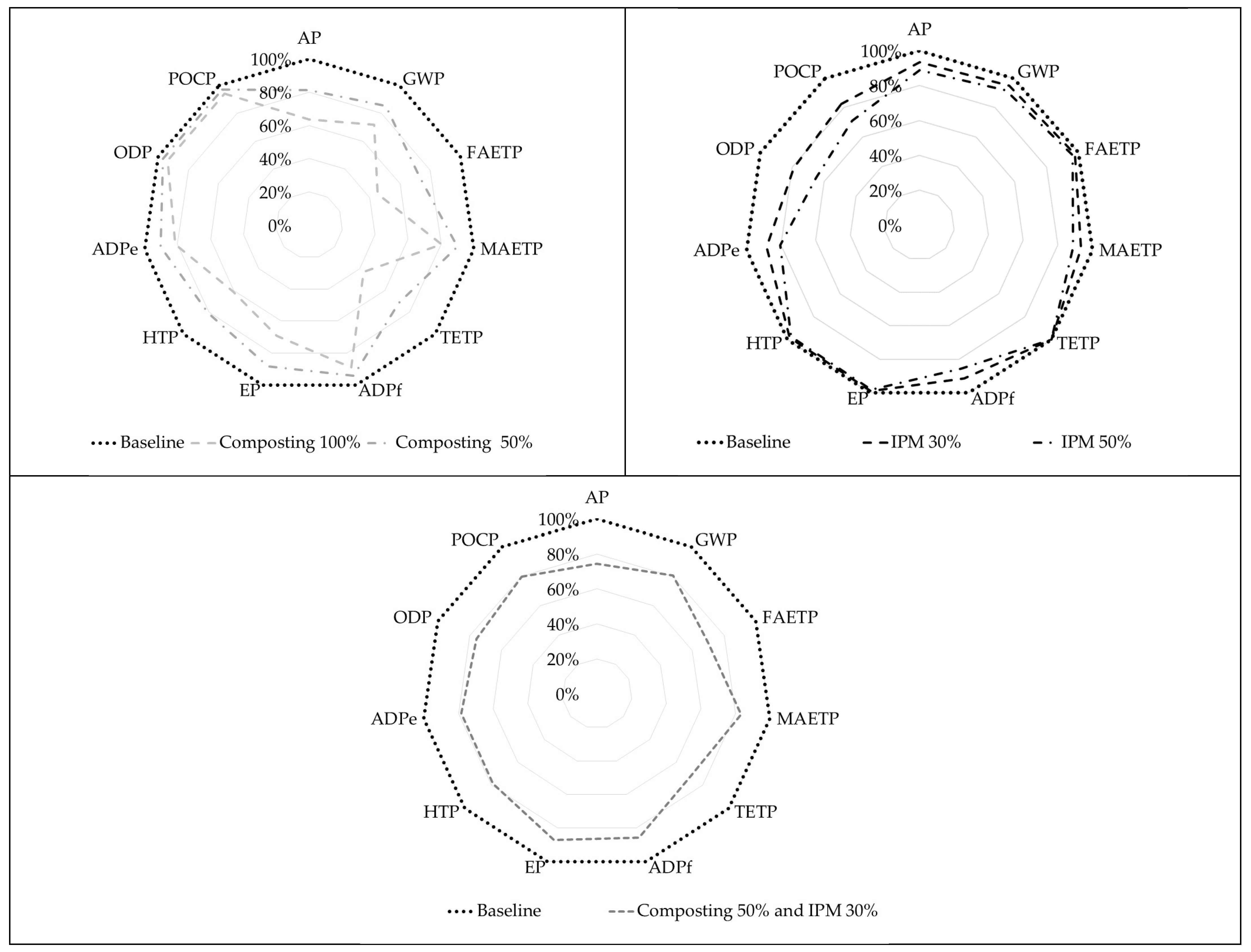Life-Cycle Assessment in Hydrangea Cultivation in Colombia and Their Cleaner Production Strategies
Abstract
:1. Introduction
2. Materials and Methods
2.1. Hydrangea Production
2.2. Goal and Scope Definition
2.2.1. Goal
2.2.2. Functional Unit
2.2.3. System Boundaries
2.2.4. Temporal Boundaries
2.3. Life-Cycle Inventory Analysis
2.4. Life-Cycle Impact Assessment and Interpretation
2.5. Sensitivity Analysis
2.6. Life Cycle Interpretation and Analysis of Cleaner Production Initiatives
- Reduced consumption of raw materials;
- Reduced emissions to the environment (water, soil, and air);
- Reduced impact on ecosystems and human health;
- Producer’s installed capacity to implement the initiative;
- Easier implementation of alternative;
- Required time horizon for implementation;
- Resources and raw materials availability in the region;
- Contribution to the achievement of the SDG.
3. Results and Discussion
3.1. Life-Cycle Inventory
3.2. Life Cycle Impact Assessment
3.3. Sensitivity Testing of Method Choices via Scenario Analysis
3.4. Cleaner Production Initiatives for Hydrangea Cultivation
3.4.1. Composting of Vegetal Waste for Fertilizer
- In the first scenario, it was assumed that all the vegetal waste currently mulching (2.841 kg/kg hydrangeas) was recovered through a composting process to obtain 1.736 kg compost/kg hydrangeas. As the compost was not sufficient to provide the phosphorus and potassium currently provided by NPK Triple 15, monoammonium phosphate (MAP) and potassium nitrate fertilizer application were included. The fertilizer quantities per kilogram of hydrangea were 0.032 kg NPK Triple 15, 0.03 kg MAP, 0.028 kg potassium nitrate, and 1.736 kg compost.
- In the second scenario, it was assumed that 50% of the vegetal waste currently mulching (1.421 kg/kg hydrangea) was recovered through a composting process to obtain 0.868 kg compost/kg hydrangea. This scenario considers that the vegetal waste mulching was also beneficial for the crop soil. Similar to scenario 1, the application of MAP and potassium nitrate was included. The fertilizer quantities per kilogram of hydrangea were: 0.100 kg NPK Triple 15, 0.016 kg MAP, 0.015 kg potassium nitrate, and 0.868 kg compost.
3.4.2. Integrated Pest Management with Biological Control and Natural Agents
- Implementation of biological control, replacing 30% of the use of chemical pesticides;
- Implementation of biological control, replacing 50% of the use of chemical pesticides.
3.4.3. Plant Waste Composting and IPM with Biological Control and Natural Agents
4. Conclusions
Supplementary Materials
Author Contributions
Funding
Institutional Review Board Statement
Informed Consent Statement
Data Availability Statement
Acknowledgments
Conflicts of Interest
References
- Ministerio de Agricultura y Desarrollo Rural. Cadena de Flores, Follajes y Ornamentales. Dirección de Cadenas Agrícolas y Forestales. 2021. Available online: https://sioc.minagricultura.gov.co/Flores/Documentos/2019-02-30CifrasSectoriales.pdf (accessed on 24 April 2021).
- Centro de Desarrollo Agrobiotecnológico de Innovación e Integración Territorial (CEDAIT). Aspectos Sociales de la Floricultura en Colombia. 2020. Available online: www.udea.edu.co/wps/wcm/connect/udea/f7bf8dd0-7161-4ca3-b2b6-70780776f2d2/Boletín+flores+aspectos+sociales+de+la+floricultura+en+colombia.pdf?MOD=AJPERES&CVID=nmvYyyv#:~:text=Desplazamiento%20de%20campesinos%20de%20sus%20tierras.&text=Aumento%20de%20desempleo%20y%20falta%20de%20oportunidades%20laborales.&text=Vulnerabilidad%20en%20niños%20y%20jóvenes,filas%20de%20los%20grupos%20armados.&text=Aparición%20de%20grupos%20armados%20al%20margen%20de%20la%20ley (accessed on 18 July 2022).
- Aguirre, M.-A.; Alzate, J.A.; Cano, N.A. Evaluación de la carga ambiental asociada a un cultivo de hortensias en La Ceja del Tambo (Antioquia-Colombia) mediante el Análisis de Ciclo de Vida. Gestión y Ambiente Ambiente 2017, 20, 210–221. [Google Scholar] [CrossRef]
- Parrado-Moreno, C.A.; Ricardo-Hernández, R.E.; Velásquez-Arredondo, H.I.; Lopera-Castro, S.H.; Hasenstab, C. An Environmental Evaluation of the Cut-Flower Supply Chain (Dendranthema grandiflora) through a Life Cycle Assessment. Revista EIA 2019, 16, 27–42. [Google Scholar] [CrossRef]
- Bonaguro, J.E.; Coletto, L.; Sambo, P.; Nicoletto, C.; Zanin, G. Environmental Analysis of Sustainable Production Practices Applied to Cyclamen and Zonal Geranium Environmental Analysis of Sustainable Production Practices. Horticulturae 2021, 7, 8. [Google Scholar] [CrossRef]
- Parrado, C.A.; Bojacá, C.R.; Schrevens, E. Exploring more sustainable technological alternatives for the greenhouse cut flowers industry in Colombia. Acta Hortic. 2011, 893, 1125–1132. [Google Scholar] [CrossRef]
- Sahle, A.; Potting, J. Environmental life cycle assessment of Ethiopian rose cultivation. Sci. Total Environ. 2013, 443, 163–172. [Google Scholar] [CrossRef] [PubMed]
- Russo, G.; Scarascia, G.; De Lucia, B. Environmental improvements of greenhouse flower cultivation by means of LCA methodology. Acta Hortic. 2008, 801, 301–308. [Google Scholar] [CrossRef]
- Alig, M.; Frischknecht, R. Life Cycle Assessment Cut Roses; Treeze Ltd.: Uster, Switzerland, 2018. [Google Scholar]
- Abeliotis, K.; Barla, S.-A.; Detsis, V.; Malindretos, G. Life cycle assessment of carnation production in Greece. J. Clean. Prod. 2016, 112, 32–38. [Google Scholar] [CrossRef]
- Michael, D. Life Cycle Assessment of Waxflowers (Chamelaucium spp.). In Proceedings of the Australian Life Cycle Assessment Society (ALCAS) Conference, Gold Coast, Australia, 19–20 July 2011. [Google Scholar]
- Beccaro, G.L.; Cerutti, A.K.; Vandecasteele, I.; Bonvegna, L.; Donno, D.; Bounous, G. Assessing environmental impacts of nursery production: Methodological issues and results from a case study in Italy. J. Clean. Prod. 2014, 80, 159–169. [Google Scholar] [CrossRef]
- Bonaguro, J.E.; Coletto, L.; Samuele, B.; Zanin, G.; Sambo, P. Environmental impact in floriculture: LCA approach at farm level. Acta Hortic. 2016, 1112, 419–424. [Google Scholar] [CrossRef]
- Soode, E.; Lampert, P.; Weber-Blaschke, G.; Richter, K. Carbon footprints of the horticultural products strawberries, asparagus, roses and orchids in Germany. J. Clean. Prod. 2015, 87, 168–179. [Google Scholar] [CrossRef]
- ISO/TR 14040; Environmental Management—Life Cycle Assessment—Principles and Framework. ISO: Geneva, Switzerland, 2007.
- ISO/TR 14044; Environmental Management—Life Cycle Assessment—Requirements and Guidelines. ISO: Geneva, Switzerland, 2006.
- Hergoualc’h, K.; Akiyama, H.; Benoux, M.; Chirinda, N.; del Prado, A.; Kasimir, A.; MacDonald, J.; Ogle, S.; Regina, K.; van der Weerden, T. N2O Emissions from managed soils, and CO2 emissions from lime and urea application. In 2019 Refinement to the 2006 IPCC Guidelines for National Greenhouse Gas Inventories; Calvo Buendia, E., Tanabe, K., Kranjc, A., Baasansuren, J., Fukuda, M., Ngarize, S., Osako, A., Pyrozhenko, Y., Shermanau, P., Federici, S., Eds.; Intergovernmental Panel on Climate Change (IPCC): Geneva, Switzerland; Kyoto, Japan, 2019. [Google Scholar]
- IPCC. IPCC Guidelines for National Greenhouse Gas Inventories. Prepared by the National Green-House Gas Inventories Programme. Japan: IGES. 2006. Available online: https://www.ipcc-nggip.iges.or.jp/public/2006gl/index.html (accessed on 18 July 2022).
- European Environment Agency (EEA). EMEP/EEA Air Pollutant Emission Inventory Guidebook 2019; Technical Guidance to Prepare National Emission Inventories; Publications Office of the European Union: Copenhagen, Denmark, 2019. [Google Scholar]
- Nemecek, T.; Bengoa, X.; Rossi, V.; Humbert, S.; Lansche, J.; Mouron, P. World Food LCA Database: Methodological Guidelines for the Life Cycle Inventory of Agricultural Products; Version 3.5; Quantis: Geneva, Switzerland, 2019; 88p. [Google Scholar]
- UPME. Calculadora Fecoc 2016 Para el Cálculo de Emisiones de CO2. 2016. Available online: http://www.upme.gov.co/calculadora_emisiones/aplicacion/calculadora.html (accessed on 16 June 2022).
- Guinée, J.B.; Gorrée, M.; Heijungs, R.; Huppes, G.; Kleijn, R.; Koning, A.; Oers, L.; Wegener Sleeswijk, A.; Suh, S.; Udo de Haes, H.A.; et al. Handbook on Life Cycle Assessment. Operational Guide to the ISO Standards. I: LCA in Perspective. IIa: Guide. IIb: Operational Annex. III: Scientific Background; Kluwer Academic Publishers: New York, NY, USA, 2002. [Google Scholar]
- CML—Department of Industrial Ecology (2016) CL-IA Characterisation Factors. Leiden University. Available online: https://www.universiteitleiden.nl/en/research/research-output/science/cml-ia-characterisation-factors (accessed on 2 August 2022).
- Zhai, Q.; Li, T.; Liu, Y. Life cycle assessment of a wave energy converter: Uncertainties and sensitivities. J. Clean. Prod. 2021, 298, 126719. [Google Scholar] [CrossRef]
- Instituto Colombiano Agropecuario (ICA); Asociación Colombiana de Exportadores de Flores (Asocolflores). Plan de Detección, Prevención y Contingencia de Thrips Palmi Karny en Ornamentales. Bogotá, Colombia. Available online: https://1library.co/document/q2n032pq-plan-deteccion-prevencion-contingencia-trips-palmi-karny-ornamentales.html (accessed on 21 July 2022).
- Dipoagro. Fertilizante NPK 15-15-15 Datasheet. 2022. Available online: https://diproagro.com/wp-content/uploads/2021/06/FICHA-TECNICA-TRIPLE-15.pdf (accessed on 19 July 2022).
- Fedearroz. Óptima Alternativa para el Control de Ácaros y Minadores: Abafed 18 E.C Datasheet. 2022. Available online: https://fedearroz.s3.amazonaws.com/media/documents/ABAFED_18_EC-FICHA_TECNICA_-_RN.pdf (accessed on 19 July 2022).
- Gowan Colombia. Magister 200 SC Datasheet. 2020. Available online: https://co.gowanco.com/sites/default/files/co_gowanco_com/_attachments/product/resource/label/ft-080-ver-cal_ft_magister.pdf (accessed on 19 July 2022).
- Arysta lifeScience. Polythion SC Datasheet. 2017. Available online: https://co.uplonline.com/download_links/zLGvxdHKI2OHMjD8SVDCzKRKv4rKIoZMsmcMdPwX.pdf (accessed on 19 July 2022).
- Dow AgroSciences LLC. Dithane M-45 WP NT. 2021. Available online: https://www.corteva.co.za/content/dam/dpagco/corteva/za/za/en/products/files/DF_4_ZA.pdf (accessed on 19 July 2022).
- XM. Reporte Integral de Sostenibilidad, Operación y Mercado 2021. Chapter 21. Oferta y Generación. Generación del Sistema Interconectado Nacional (SIN). 2021. Available online: https://informeanual.xm.com.co/informe/pages/xm/21-generacion-del-sin.html (accessed on 21 July 2022).
- Comotos. Bajaj Pulsar 135 LS | Precio, Ficha Técnica y Características. 2022. Available online: https://comotos.co/bajaj-pulsar-135-ls-precio-ficha-tecnica-y-caracteristicas/ (accessed on 19 July 2022).
- Sumatec. Las Guadañas Ideales para el Corte de Pasto y Maleza. 2020. Available online: https://sumatec.co/las-guadanas-ideales-para-el-corte-de-pasto-y-maleza/ (accessed on 20 June 2022).
- United States Environmental Protection Agency (EPA). AP-42: Compilation of Air Emissions Factors. 2009. Available online: https://www.epa.gov/air-emissions-factors-and-quantification/ap-42-compilation-air-emissions-factors (accessed on 16 June 2022).
- Gençer, E.; Burniske, G.R.; Doering, O.C., III; Tyner, W.E.; Agrawal, R.; Delgass, W.N.; Ejeta, G.; McCann, M.C.; Carpita, N.C. Sustainable production of ammonia fertilizers from biomass. Biofuel Bioprod. Biorefin. 2020, 14, 725–733. [Google Scholar] [CrossRef]
- Sociedad de Agricultores de Colombia and Ministerio de Ambiente (Colombia). Guía Ambiental para la Floricultura. 2002. Available online: http://hdl.handle.net/20.500.12324/13087 (accessed on 19 July 2022).
- Intergovernmental Panel on Climate Change (IPCC). Climate Change 2021: The Physical Science Basis; Contribution of Working Group I to the Sixth Assessment Report of the Intergovernmental Panel on Climate Change; Cambridge University Press: Cambridge, UK; New York, NY, USA, 2021. [Google Scholar]
- Zhang, X.; Davidson, E.A.; Mauzerall, D.L.; Searchinger, T.D.; Dumas, P.; Shen, Y. Managing nitrogen for sustainable development. Nature 2015, 528, 51–59. [Google Scholar] [CrossRef]
- Cameron, K.C.; Di, H.J.; Moir, J.L. Nitrogen losses from the soil/plant system: A review. Ann. Appl. Biol. 2013, 162, 145–173. [Google Scholar] [CrossRef]
- Fowler, D.; Coyle, M.; Skiba, U.; Sutton, M.A.; Cape, J.N.; Reis, S.; Sheppard, L.J.; Jenkin, A.; Grizzetti, B.; Galloway, J.N.; et al. The global nitrogen cycle in the twenty-first century. Philos. Trans. R. Soc. Lond. B Biol. Sci. 2013, 368, 20130164. [Google Scholar]
- Sharma, S.B.; Sayyed, R.Z.; Trivedi, M.H.; Gobi, T.A. Phosphate solubilizing microbes: Sustainable approach for managing phosphorus deficiency in agricultural soils. SpringerPlus 2013, 2, 587. [Google Scholar] [CrossRef] [PubMed]
- Sarkar, S.; Dias, J.; Keeley, J.; Möhring, N.; Jansen, K. The Use of Pesticides in Developing Countries and Their Impact on Health and the Right to Food Policy Department for External Relations; European Parliament: Strasbourg, France, 2021. [Google Scholar]
- Wainwright, H.; Jordan, C.; Day, H. Environmental impact of production horticulture. In Horticulture: Plants for People and Places; Dixon, G.R., Aldous, D.E., Eds.; Springer: Berlin/Heidelberg, Germany, 2014; Volume 1. [Google Scholar]
- Flórez, G.Y.; Calderón, P.A. Análisis de beneficios socio-ambientales por la implementación de estrategias de producción más limpias en el sector agropecuario de la cuenca media del río Chinchiná, Colombia. Acta Agrónomica 2014, 63, 193–203. [Google Scholar]
- Du, S.; Liu, J.; Fu, Z. The Impact of Village Rules and Formal Environmental Regulations on Farmers’ Cleaner Production Behavior: New Evidence from China Impact of Village Rules and Formal Environmental Regulations on Farmers’ Cleaner Production Behavior: New Evidence from China. Int. J. Environ. Res. Public Health 2021, 18, 7311. [Google Scholar] [CrossRef]
- Dennis, J.H.; Lopez, R.G.; Behe, B.K.; Hall, C.R.; Yue, C.; Campbell, B.L. Sustainable Production Practices Adopted by Greenhouse and Nursery Plant Growers. HortScience 2010, 45, 1232–1237. [Google Scholar] [CrossRef]
- Hall, T.J.; Lopez, R.G.; Marshall, M.I.; Dennis, J.H. Barriers to Adopting Sustainable Floriculture Certification. HortScience 2010, 45, 778–783. [Google Scholar] [CrossRef]
- Universidad Pontificia Bolivariana (UPB). Informe Interno: Compostaje UPB—Sede Central Ecocampus; Universidad Pontificia Bolivariana (UPB): Medellín, Colombia, 2019. [Google Scholar]
- Organización de las Naciones Unidas para la Alimentación y la Agricultura (FAO). Manual de Compostaje del Agricultor. Experiencias en América Latina, Santiago de Chile; Organización de las Naciones Unidas para la Alimentación y la Agricultura (FAO): Rome, Italy, 2013. [Google Scholar]
- Boldrin, A.; Hartling, K.R.; Laugen, M.; Christensen, T.H. Environmental inventory modelling of the use of compost and peat in growth media preparation. Resour. Conserv. Recycl. 2010, 54, 1250–1260. [Google Scholar] [CrossRef]
- Clasificación Recomendada por la OMS de los Plaguicidas por el Peligro que Presentan y Directrices para la Clasificación de 2019; WHO (World Health Organization): Geneva, Switzerland, 2020.
- De, A.; Bose, R.; Kumar, A.; Mozumdar, S. Targeted Delivery of Pesticides Using Biodegradable Polymeric Nanoparticles; Springer Briefs in Molecular Science; Springer: New Dehli, India, 2014. [Google Scholar]
- Bioquirama. Bioinsumos. 2022. Available online: https://bioquirama.com/index.php/bioinsumos (accessed on 6 November 2022).
- Góngora, C.; Marín, P.; Benavides, P. Claves para el éxito del hongo Beauveria Bassiana como Controlador Biológico de la Broca del café. Cenicafé (384). 2009. Available online: https://www.cenicafe.org/es/publications/avt0384.pdf (accessed on 7 November 2022).
- Pineda-López, B. Ampelomyces Quisqualis Parasitando Pseudoidium Hortensiae en Hortensia (Hydrangea macrophylla). Fitopatología Colombiana 2019, 43, 25–38. [Google Scholar]
- Páez, A. Herramientas Actuales y Aspectos Importantes Para el Control de Plagas. 2021. Available online: https://Avgust.Com.Co/Herramientas-Actuales-y-Aspectos-Importantes-Para-El-Control-de-Plagas/ (accessed on 7 November 2022).
- Daza, M.; Cantor, F.; Rodríguez, D.; Bustos, A.; Cure, J. Criterios para la producción de Phytoseiulus persimilis bajo condiciones de invernadero. Acta Biológica Colombiana 2010, 15, 37–46. [Google Scholar]
- Brun, R.; Metay, C.; Wdziekonski, C.; Gronier, M.C. Evaluation of Integrated Pest Management for Rose and Its Consequences on Flower Quality. Acta Hortic. 2012, 927, 245–252. [Google Scholar] [CrossRef]
- Mabbett, T. Los Aceites Vegetales se Usan para Combatir las Plagas de los Cultivos. El Plamicultor. (255). 1992. Available online: https://publicaciones.fedepalma.org/index.php/palmicultor/article/view/5260/5251%20 (accessed on 19 July 2022).
- Deguine, J.-P.; Aubertot, J.-N.; Joy, R.; Lescourret, F.; Wyckhuys, K.; Ratnadass, A. Integrated pest management: Good intentions, hard realities. A review. Agron. Sustain. Dev. 2021, 41, 5–35. [Google Scholar] [CrossRef]
- Ndegwa, P.M. Enhancing Composting and Bioconversion of Organic Waste. Ph.D. Thesis, University of Georgia, Athens, GA, USA, 1999. [Google Scholar]
- Duarte, F. El control biológico como estrategia para apoyar las exportaciones agrícolas no tradicionales en Perú: Un análisis empírico. Contabilidad y Negocios 2012, 7, 81–100. [Google Scholar] [CrossRef]




| Impact Category | Unit | Result |
|---|---|---|
| Acidification | kg SO2 eq | 0.012 |
| Climate change | kg CO2 eq | 0.961 |
| Freshwater aquatic ecotoxicity | kg 1,4-DB eq | 1.207 |
| Marine aquatic ecotoxicity | kg 1,4-DB eq | 803.897 |
| Terrestrial ecotoxicity | kg 1,4-DB eq | 0.572 |
| Abiotic depletion potential: fossil fuels | MJ | 10.668 |
| Eutrophication | kg PO42− eq | 0.008 |
| Human toxicity | kg 1,4-DB eq | 3.036 |
| Abiotic depletion potential: Metals | kg Sb eq | 1.172 × 10−5 |
| Ozone depletion | kg CFC-11 eq | 7.755 × 10−8 |
| Photochemical oxidant formation | kg C2H2 eq | 2.382 × 10−4 |
| Environmental Aspect | Cleaner Production Initiative | Priority |
|---|---|---|
| Soil use | Mulching of vegetal waste in a controlled manner and reducing waste size | 5 |
| Establishment of agroforestry systems in crops and alongside water sources | 7 | |
| Infrastructure materials use | Replacement of crop infrastructure materials (wooden poles) with recycled materials. | 9 |
| Fertilization | Formulating fertilization from soil analysis or good nutrient management (GNM) | 3 |
| Use of organic fertilizers such as manure, compost, biochar, vegetal waste, sludge, etc. | 17 | |
| Use of controlled-release fertilizers | 10 | |
| Phytosanitary management | Integrated pest management (IPM) with biological control using natural agents to reduce pesticide application | 2 |
| Use of controlled-release pesticides | 13 | |
| Water consumption | Rainwater harvesting through construction of reservoirs and canals | 6 |
| Post-harvest water reuse | 8 | |
| Recirculation of crop water through a closed system with biological treatment | 12 | |
| Wastewater generation | Biological wastewater treatment with wetland or phytoremediation systems | 16 |
| Solid waste generation | Composting of vegetal waste for fertilizer | 1 |
| Vermicomposting of vegetal wastes | 4 | |
| Anaerobic digestion of vegetal waste for biogas production | 15 | |
| Obtaining biochar through thermochemical processes, such as pyrolysis and gasification, for soil remediation, activated carbon, or energy recovery | 11 | |
| Obtaining products such as pallets, boards, or materials with thermal properties from hydrangea stems | 14 | |
| Production of liquid fuels and other chemicals by biorefinery processes | 18 |
Disclaimer/Publisher’s Note: The statements, opinions and data contained in all publications are solely those of the individual author(s) and contributor(s) and not of MDPI and/or the editor(s). MDPI and/or the editor(s) disclaim responsibility for any injury to people or property resulting from any ideas, methods, instructions or products referred to in the content. |
© 2024 by the authors. Licensee MDPI, Basel, Switzerland. This article is an open access article distributed under the terms and conditions of the Creative Commons Attribution (CC BY) license (https://creativecommons.org/licenses/by/4.0/).
Share and Cite
González, M.A.; Arenas, C.N.; Ríos, J.A.; Miranda, J.; Bello, A.P.; Botero, J.; Betancur, M. Life-Cycle Assessment in Hydrangea Cultivation in Colombia and Their Cleaner Production Strategies. Sustainability 2024, 16, 887. https://doi.org/10.3390/su16020887
González MA, Arenas CN, Ríos JA, Miranda J, Bello AP, Botero J, Betancur M. Life-Cycle Assessment in Hydrangea Cultivation in Colombia and Their Cleaner Production Strategies. Sustainability. 2024; 16(2):887. https://doi.org/10.3390/su16020887
Chicago/Turabian StyleGonzález, María Alejandra, Cindy Natalia Arenas, José Adrián Ríos, Juliana Miranda, Ana Patricia Bello, Jaime Botero, and Mariluz Betancur. 2024. "Life-Cycle Assessment in Hydrangea Cultivation in Colombia and Their Cleaner Production Strategies" Sustainability 16, no. 2: 887. https://doi.org/10.3390/su16020887





